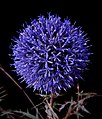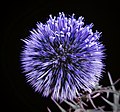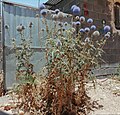| Echinops | |
|---|---|

| |
| Echinops adenocaulos | |
| Scientific classification | |
| Kingdom: | Plantae |
| Clade: | Tracheophytes |
| Clade: | Angiosperms |
| Clade: | Eudicots |
| Clade: | Asterids |
| Order: | Asterales |
| Family: | Asteraceae |
| Subfamily: | Carduoideae |
| Tribe: | Cardueae |
| Subtribe: | Echinopsinae Dumort. |
| Genus: | Echinops L. |
| Species | |
|
About 130 species, see text | |
Echinops /ˈɛkɪnɒps/ is a genus of about 130 species of flowering plants in the family Asteraceae, commonly known as globe thistles. They have spiny foliage and produce blue or white spherical flower heads. They are distributed from central Asia, Mongolia and north-eastern China to the Mediterranean basin, temperate regions of Eurasia, reaching to Indian subcontinent and tropical Africa. Globe thistle is the host plant of weevils Larinus vulpes and Larinus onopordi.
Characteristics

Source:
Vegetative charactreistic
The globe thistle species are perennial herbaceous plants. They form rhizomes as perennial organs. The independently upright stems are angular. The alternately arranged leaves are one to two-pinnately divided and white, woolly and tomentose on the underside.
Generative features

The capitulas are single-flowered, have a hermaphrodite tubular flower and are surrounded by a multi-rowed sheath. Numerous capitulas form spherical inflorescences of the second order, which have a diameter of 4 to 8 centimeters. The capitulas bloom from top to bottom within a head. The corolla is tubular, divided almost to the base. The flower color is steel blue to white, the inflorescences as a whole are usually bluish. The stamens are blue-gray. The achenes are cylindrical, pentagonal and hairy. The pappus has short scales.
Traditional uses
Many species belonging to the genus Echinops are traditionally used as medicinals mainly in Africa and Asia. The genus is reported to contain diverse secondary metabolites. More than 151 secondary metabolites have been reported in this genus which thiophenic compounds held the biggest share. Various extracts, essential oils, and isolated compounds from members of this genus are shown to exhibit different biological effects mainly anti-microbial, anti-proliferative, and anti-inflammatory. However, there are a number of species in this genus that are claimed to have traditional medicinal uses but their biological effect not yet been evaluated. The common traditional uses can fall into three general groups. The frequently described application is to treat symptoms like inflammation, pain, and fever. The other common traditional uses is to treat ailments related to respiratory tract including cough and sore throat. Members of the genus have been used as an aphrodisiac, facilitation of expulsion of retained placenta and delivery, as an abortifacient, treatment of uterus tumor and leucorrhoea.
Selected species
Species include:
- Echinops adenocaulos
- Echinops amplexicaulis
- Echinops bannaticus
- Echinops cephalotes
- Echinops ceratophorus
- Echinops chantavicus
- Echinops echinatus
- Echinops exaltatus
- Echinops giganteus
- Echinops gmelinii
- Echinops graecus
- Echinops humilis
- Echinops kotschyi
- Echinops latifolius
- Echinops longisetus
- Echinops macrophyllus
- Echinops nivens
- Echinops niveus
- Echinops orientalis
- Echinops persepolitanus
- Echinops ritro (syn. Echinops ruthenicus)
- Echinops sahyadricus
- Echinops setifer
- Echinops sphaerocephalus
- Echinops spinosissimus
- Echinops tournefortii
- Echinops tschimganicus
Gallery
-
 Echinops setifer in Japan
Echinops setifer in Japan
-
 Echinops adenocaulos in north Africa
Echinops adenocaulos in north Africa
-
 Echinops adenocaulos before flowering
Echinops adenocaulos before flowering
-
 Echinops sphaerocephalus in Setif, Algeria
Echinops sphaerocephalus in Setif, Algeria
-
Echinops ruthenicus
-
 Echinops spinoissimus in Greece
Echinops spinoissimus in Greece
-
 Echinops macrophyllus in Iran
Echinops macrophyllus in Iran
-
 Echinops macrophyllus
Echinops macrophyllus
-
 Echinops sphaerocephalus in Russia
Echinops sphaerocephalus in Russia
References
- Sunset Western Garden Book, 1995:606–607
- RHS A-Z encyclopedia of garden plants. United Kingdom: Dorling Kindersley. 2008. p. 1136. ISBN 978-1405332965.
- Montazerolghaem, Somayeh; Susanna, Alfonso; Calleja, Juan Antonio; Mozaffarian, Valiollah; Rahiminejad, Mohammad Reza (2017). "Molecular systematics and phylogeography of the genus Echinops (Compositae, Cardueae–Echinopsinae): Focus on the Iranian centre of diversification". Phytotaxa. 297 (2): 101. doi:10.11646/phytotaxa.297.2.1.
- Skuhrovec, Jiří; Volovnik, Semyon; Gosik, Rafał (2017-06-12). "Description of the immature stages of Larinus vulpes and notes on its biology (Coleoptera, Curculionidae, Lixinae)". ZooKeys (679): 107–137. Bibcode:2017ZooK..679..107S. doi:10.3897/zookeys.679.12560. ISSN 1313-2970. PMC 5523399. PMID 28769711.
- "Echinops in Flora of North America @ efloras.org". www.efloras.org. Retrieved 2024-07-21.
- Bitew, Helen; Hymete, Ariaya (2019-11-01). "The Genus Echinops: Phytochemistry and Biological Activities: A Review". Frontiers in Pharmacology. 10: 1234. doi:10.3389/fphar.2019.01234. ISSN 1663-9812. PMC 6838032. PMID 31736749.
- Ghasemi, Pirbalouti A.; Momeni, M.; Bahmani, M. (2013). "Ethnobotanical study of medicinal plants used by Kurd tribe in Dehloran and Abdanan districts, Ilam province, Iran". African Journal of Traditional, Complementary and Alternative Medicines. 10 (2): 368–385. doi:10.4314/ajtcam.v10i2.24. PMC 3746586. PMID 24146463. Retrieved 2024-07-21.
- Okello, Jimmy; Ssegawa, Paul (2007). "Medicinal plants used by communities of Ngai Subcounty, Apac District, northern Uganda". African Journal of Ecology. 45: 76–83. Bibcode:2007AfJEc..45S..76O. doi:10.1111/j.1365-2028.2007.00742.x.
This Cardueae article is a stub. You can help Misplaced Pages by expanding it. |